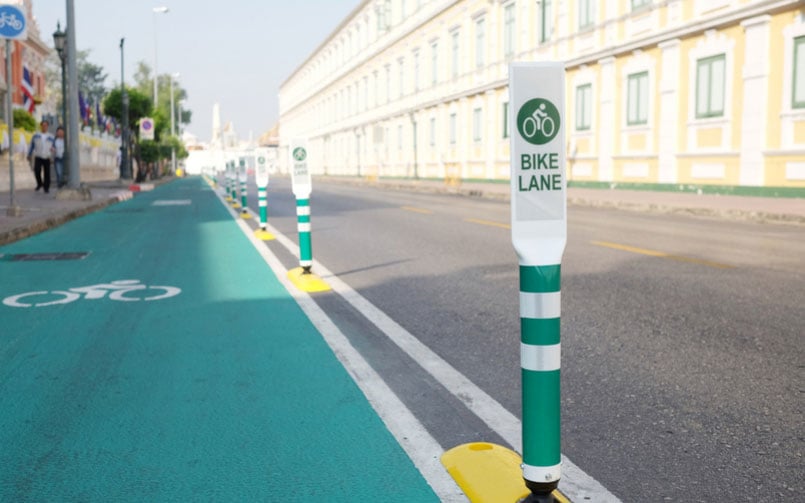Adding protected bike lanes clearly benefits cyclists, but it offers a lot more benefits as well—some of which might surprise you. Protected bike lanes increase safety for pedestrians, increase business for local shops, and have the potential to reduce traffic.
Different barriers are commonly used for protected bike lanes, such as parked cars (great for busy cities that need more parking spaces), planters, or bollards. The goal is to provide a physical barrier between cyclists and automobiles. On the other hand, unprotected bike lanes rely on lines striped in the road to signal where cyclists have the right of way—and this can lead to a lot of room for error and accident.
Protected bike lanes are commonly seen in busy cities where riding a bike is often quicker than taking a car. New York, San Francisco, and Chicago are just some of the larger cities to implement protected bike lanes in recent years.
There are so many benefits to protected bike lanes that there’s even a National Protected Bike Lane Week in early May! Around 7 years ago, an increase in protected bike lanes showed the world the benefits of providing safe spaces for people to bike on roadways. Since 2009, protected bike lanes have doubled in numbers every two years. 82 cities in 34 states in the US have added protected bike lanes.
4 Benefits of Protected Bike Lanes
1. Greater Safety, Reduced Accidents & Injuries
Many bike lanes are unprotected, leaving cyclists more vulnerable to accident. In fact, according to a published study titled Route Infrastructure and the Risk of Injuries to Bicyclists, protected bike lanes increase safety and reduce injuries by 89%. This isn’t just good for cyclists, it’s also good for drivers. For one, it gives drivers one less thing to worry about out on the road. Secondly, it can reduce traffic because if there is an injury or accident between a driver and a cyclist, it’ll cause backups.
A study shared in the Chicago Tribune reported a 161% increase in bike riders following stoplight signals after adding protected bike lanes.
2. Increased Safety and Walkability for Pedestrians
Adding protected bike lanes can reduce biking on sidewalks by as much as 56%. When pedestrians don’t have to share the sidewalk with bikers, it becomes safer for them to walk places. It also leaves more room for people to stroll in groups, push a stroller, etc. By making pedestrians feel more comfortable, you can increase foot traffic, which can have economic benefits (more on that in a minute).
Protected bike lanes calm traffic and decrease crossing distances. In fact, pedestrian injuries decreased considerably in New York City following the addition of protected bike lanes.
3. Increases Storefront Sales
Local businesses will be pleased to learn that adding protected bike lanes can increase sales. The NYC Department of Transportation reported a 49% increase in business after installing protected bike lanes to 9th Avenue. Surrounding streets in the area that did not get new protected bike lanes only saw a 3% increase in sales. Perhaps it has something to do with the fact 55% of bikers will go out of their way to utilize a street with solid bike infrastructure, according to a Portland-based study by Jennifer Dill. As a result, streets with protected bike lanes get more traffic from cyclists, and more traffic equates to more business.
4. Promotes More Bikers & Less Drivers
Within the first year of adding protected bike lanes, cities documented an average 75% increase in the number of bikes. Makes sense considering 71% of Americans reported they would like to ride bikes more often but have concerns over the safety of riding bikes on roadways, according to NHTSA Volume II: Findings Report National Survey of Bicyclist and Pedestrian Attitudes and Behavior. By adding protected bike lanes, people are more likely to ditch their car and hop on a bike and that’s a good thing.
More bikers in your city can:
- Reduce roadway traffic, each bike on the road is one less car on the road
- Reduce wear and tear on roadways
- Decrease pollution
- Create a healthier community environment
You can encourage the development of more protected bike lanes by talking to your elected officials.
What Are Protected Bike Lanes Made of?
45% of protected bike lanes rely on concrete curbs, fences, or planters
30% create parking spaces so that parked cars provide the barrier
25% add posts or bollards
We offer the strongest planters (browse planters) and bollards (browse bollards) around—capable to stand up to all kinds of wear and tear.

